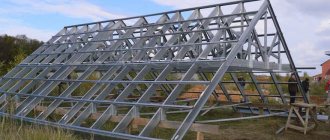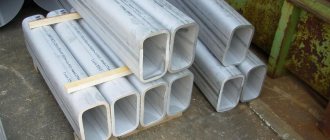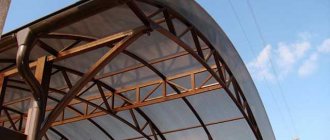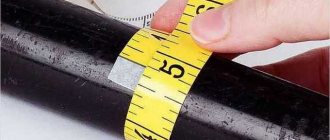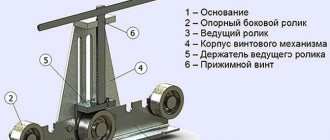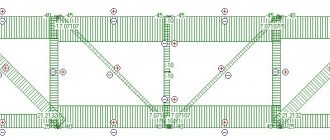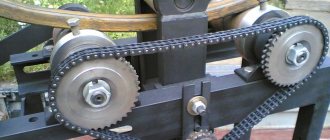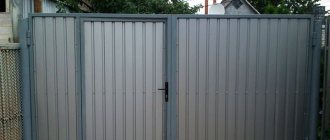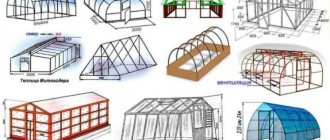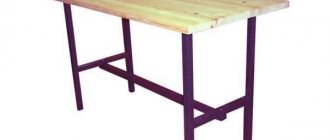Construction science is a complex relationship between physics and mathematics; it cannot be done without certain knowledge and the ability to calculate various values. For example, to properly organize transportation, it is important to know in advance the weight of the profile pipe, and not just its dimensions and dimensions, otherwise you may simply choose a vehicle for transportation or not fit all the pipes into one vehicle.
Let's figure out how to calculate the specific gravity of a certain type of pipe, what types of pipes there are, and the best way to transport them.
Types and sizes of pipes
Profile pipes are very popular today and are used in various construction activities, from laying paving slabs to welding work. In this regard, there are several types of metal profile pipes on the market:
- Rectangular;
- Square;
- Oval;
- Flat oval;
- Hexagonal;
- Triangular.
The most popular types of profiles are rectangular, square and oval pipes.
There is also a wide range of standard sizes of profile pipes. Standard professional pipes have a diameter from 15 to 300 millimeters, a wall thickness from 1 to 12 millimeters, but the weight is determined using a special mold - it directly depends on the shape of the pipe and what dimensions it has.
Limit deviations and tolerances
The maximum deviations in the wall thickness of the profiles must correspond to the maximum deviations in the thickness of the initial workpiece with a width of 1250 mm of normal rolling accuracy B according to GOST 19903 . Maximum thickness deviations do not apply to bending areas.
- Maximum deviations in height and width of the profile must correspond to:
- with profile height (width) up to 100 mm ... ±1.0, but not less
- with a profile height (width) over 100 mm ... ± 0.8.
- Tolerances for external rounding radii must comply with:
- at t ≤ 6.0 mm…………….from 1.6t to 2.4t
- at 6.0 < t ≤ 10.0 mm……..from 2.0t to 3.0t
- at t ≥ 10.0 mm……………from 2.4t to 3.6t.
In the cross section of the profile, deviations from the angle of 90° should not exceed ± 1°30′.
Tables of weight of steel pipes of various GOST and TU 1 meter
In order to calculate the specific gravity of a profile, a special table of the weight of a profile pipe is used, with which you can calculate the mass of a certain type of pipe by multiplying the length by the weight of a linear meter.
Using special tables, you can determine how many meters are in a ton of pipeline.
The characteristics of the best manufacturers and the standard sizes of their products are given in the tables below.
GOST 8639 82 – Square steel pipes
| Section square parameters | Weight of 1 linear meter |
| 15×15x1.0 | 0,479 |
| 15×15x1.2 | 0,501 |
| 15×15x1.5 | 0,605 |
| 20×20x1.2 | 0,689 |
| 20×20x1.5 | 0,841 |
| 20×20x2 | 1,08 |
| 25×25x1.2 | 0,877 |
| 25×25x1.5 | 1,07 |
| 25×25x2 | 1,39 |
| 30×30x1.5 | 1,31 |
| 30×30x2 | 1,70 |
| 40×40x1.5 | 1,78 |
| 40×40x2 | 2,33 |
| 40×40x2.5 | 2,85 |
| 40×40x3 | 3,36 |
| 40×40x4 | 4,30 |
| 50×50x2.5 | 3,64 |
| 50×50x3 | 4,31 |
| 50×50x3.5 | 4,94 |
| 50×50x4 | 5,56 |
| 60×60x2 | 3,59 |
| 60×60x2.5 | 4,43 |
| 60×60x3 | 5,25 |
| 60×60x3.5 | 6,04 |
| 60×60x4 | 6,82 |
| 80×80x3 | 7,13 |
| 80×80x4 | 9,33 |
| 80×80x5 | 11,44 |
| 80×80x6 | 13,46 |
| 100×100x3 | 9,02 |
| 100×100x4 | 11,84 |
| 100×100x5 | 14,58 |
| 100×100x6 | 17,22 |
| 100×100x7 | 17,3 |
| 100×100x8 | 22,25 |
| 120×120x4 | 14,35 |
| 120×120x5 | 17,72 |
| 120×120x6 | 20,99 |
| 120×120x8 | 27,27 |
| 140×140x5 | 20,86 |
| 140×140x6 | 24,76 |
| 150×150x5 | 22,43 |
| 150×150x6 | 26,64 |
| 150×150x8 | 34,81 |
| 160×160x4 | 19,38 |
| 160×160x5 | 24,00 |
| 160×160x6 | 28,53 |
| 160×160x8 | 37,32 |
| 180×180x5 | 27,14 |
| 180×180x6 | 32,30 |
| 180×180x8 | 42,34 |
| 180×180x10 | 52,03 |
| 200×200x6 | 36,06 |
| 200×200x8 | 47,37 |
| 200×200x10 | 58,31 |
| 200×200x12 | 68,89 |
| 250×250x6 | 45,48 |
| 250×250x8 | 59,93 |
| 250×250x10 | 74,01 |
| 250×250x12 | 87,73 |
| 300×300x6 | 54,90 |
| 300×300x8 | 72,49 |
| 300×300x10 | 89,71 |
| 300×300x12 | 106,6 |
GOST 8645 82 – Rectangular steel pipes
| Options | Weight of 1 linear meter |
| 20x10x1.2 | 0,501 |
| 20x10x1.5 | 0,605 |
| 25x10x1.5 | 0,723 |
| 28x25x1.2 | 0,934 |
| 28x25x1.5 | 1,15 |
| 28x25x2 | 1,48 |
| 30x15x1.5 | 0,959 |
| 30x20x1.5 | 1,08 |
| 30x20x2 | 1,39 |
| 40x20x1.5 | 1,31 |
| 40x20x2 | 1,70 |
| 40x25x1.5 | 1,43 |
| 40x25x2 | 1,86 |
| 40x25x2.5 | 2,27 |
| 50x25x1.5 | 1,67 |
| 50x20x2 | 2,02 |
| 50x25x2 | 2,17 |
| 50x30x2 | 2,32 |
| 50x30x2.5 | 2,86 |
| 50x40x2.0 | 2,65 |
| 50x40x2.5 | 3,25 |
| 50x40x3.5 | 4,39 |
| 60x30x2 | 2,65 |
| 60x30x2.5 | 3,25 |
| 60x30x3 | 3,83 |
| 60x40x2 | 2,96 |
| 60x40x3 | 4,30 |
| 60x40x3.5 | 4,94 |
| 60x40x4 | 5,56 |
| 80x40x2 | 3,59 |
| 80x40x2.5 | 4,43 |
| 80x40x3 | 5,25 |
| 80x40x4 | 6,82 |
| 80x60x3 | 6,19 |
| 80x60x4 | 8,07 |
| 100x50x3 | 6,66 |
| 100x50x4 | 8,70 |
| 100x50x5 | 10,65 |
| 100x60x3 | 7,13 |
| 100x60x4 | 9,33 |
| 100x60x5 | 11,44 |
| 100x80x4 | 10,59 |
| 100x80x5 | 13,01 |
| 120x60x3 | 8,07 |
| 120x60x4 | 10,59 |
| 120x60x5 | 13,00 |
| 120x80x4 | 11,84 |
| 120x80x5 | 13,01 |
| 120x80x6 | 17,22 |
| 140x60x4 | 11,84 |
| 140x60x5 | 14,58 |
| 140x100x4 | 14,35 |
| 140x100x5 | 17,72 |
| 140x100x6 | 20,99 |
| 150x100x5 | 18,50 |
| 150x100x6 | 21,93 |
| 150x100x8 | 28,53 |
| 160x80x5 | 17,72 |
| 160x120x5 | 20,86 |
| 160x120x6 | 24,76 |
| 180x100x6 | 24,76 |
| 180x100x8 | 32,29 |
| 200x120x5 | 24,00 |
| 200x120x6 | 28,53 |
| 200x160x5 | 27,14 |
| 200x160x6 | 32,30 |
| 230x160x8 | 46,11 |
Of course, for convenience, when purchasing a pipe, it can be cut into several parts, so take into account that the length can be from 3 to 12 meters, depending on the client’s wishes. There are also special sizes that differ from the standard ones; if necessary, they can be ordered on an individual basis. And now you can figure out how the weight of a linear meter of a profile pipe is calculated.
Profile pipe
View price - Profile pipe
- Square pipe
- Rectangular pipe
- Bent steel profile
A metal profile pipe is a steel product of square, rectangular, oval and other cross-sections other than round.
Used in construction: both for critical structures with high reliability requirements, and in the manufacture of various lightweight structures (kiosks, greenhouses, building frames made of profile pipes ); in agriculture ( trusses made of profile pipes ), mechanical engineering, in the decoration of premises, the manufacture of stairs, fences ( fences made of profile pipes ), the production of furniture, commercial equipment, for the manufacture of decorative elements for various purposes and for other purposes.
The production of profile pipes is carried out using hot and cold deformation methods, and therefore profile pipes are distinguished:
- welded, - seamless
According to their cross-section, profile pipes are divided into:
– square, – rectangular profile pipes – oval – polygonal
According to the material used, pipes are divided into: steel pipes, aluminum profile pipes , stainless steel profile pipes and galvanized profile pipes . Galvanized pipes have anti-corrosion properties and extend the service life of the product, improving the appearance of the structure. Galvanized profile pipes are used for advertising stands, children's or sports grounds, bus stops, etc.
Manufacturing of profile pipes
Profile pipes are made from strips or sheet steel. The strip in the form of a roll is cut into strips of a certain width, then passes through a forming machine and acquires a round cross-section. Depending on the technology used to manufacture the pipe, the formation of a round pipe occurs when the metal is hot or cold. Then welding is used: in a gas-shielded environment (for critical products), inductor or another method. The rollers apply compression force to increase the strength of the joint. When welding, a layer of metal is formed from the seam - burr, which is removed with a cutter. After cooling with emulsion, a round pipe is sent to forming rollers, which apply pressure from various sides and give the required profile. Then the quality of the pipe is checked, cut into measured pieces and heat treatment, due to which the internal stresses in the pipe that were formed during the deformation process are removed, thanks to this treatment the quality of the product is significantly improved.
To reduce costs, a production technology is used without the stage of deforming a round pipe: the required profile is immediately formed from the strip, after the forming mill the pipe enters the welding mill and then goes through all the stages described above, maybe with or without heat treatment.
Profile steel pipes are manufactured by: Severstal OJSC, Naberezhnye Chelny Trubny CJSC, Proizvodstvennaya LLC, Tolyatti Profile and Pipe Plant LLC, Managing Holding Company Korolevsky Trubny CJSC.
Electric-welded straight-seam steel pipes TU 14-105-737-2004.
These technical specifications apply to electric-welded steel pipes made of carbon and low-alloy steel grades, without subsequent heat treatment, of various sections: round, square, rectangular, semi-oval and flat-oval. Such pipes are used for general purposes and for the production of structures and furniture. They are manufactured using high-frequency electric welding without heat treatment of the longitudinal weld. Transverse welds used to join the strip into a continuous strip to form a pipe are not permitted in the finished product.
Buy a profile pipe
From us you can purchase steel profile pipes of all types produced: rectangular profile pipes , from branch warehouses, warehouses in the Moscow region or directly from the factory. We provide services for cutting, delivery and assembly of profile pipes. Availability, weight of profile pipes , per ton of profile pipes rectangular pipes, GOST assortment, you can see on the website. More detailed information on profile pipes price per meter, steel rectangular pipes price per rod, clarify profile pipe dimensions , GOST profile pipe , make a profile pipe calculation , issue an invoice and fill out an application, clarify payment options and request a certificate - you can contact the manager by contacting them according to
phone, e-mail: [email protected]
Pipe weight calculator
The formula for calculating the specific gravity of a profile is quite difficult to master; it takes into account the following indicators:
- Material density;
- The width and height of the profile section or its diameter;
- Wall thickness;
- Pipe length;
If you use stainless steel pipes, you can use the tables above for calculations, simply multiplying the pipe length in meters by the specific gravity of 1 linear meter, which is indicated in the table opposite the profile size.
If you decide to purchase a galvanized profile, aluminum profile or copper profile pipes, you can calculate the specific gravity using a special calculator. In it you can select materials, for example stainless steel, enter dimensions and calculate the weight of the pipe, whether it is thick-walled or thin-walled, you can also read the values from the reference book. Here you can calculate the density of the material.
Rolled metal calculator © metcalc.ru
Unfortunately, this calculator cannot calculate how much plastic pipes weigh; it can only indicate various metal materials and calculate their theoretical weight.
Marking - symbols. GOST
b - width, h - height, t - wall thickness, R - radius of external curvature.
The symbol for a bent welded rectangular profile with a height of 180mm , a width of 100mm , a wall thickness of 5mm made of steel for building structures C245 according to GOST 27772 will look like this:
Profile 180x100x5 GOST 30245 - 2003/C245 GOST27772-88
But suppliers usually use simplified markings, which include: name, cross-sectional size and wall thickness. Thus, if you see on Petrovich’s website the position: profile pipe 60x40x2 , this will mean that the construction network offers a rectangular pipe with a profile width of 60x40mm and a wall thickness of 2mm .
The profile is made in lengths from 6 to 12 m and sometimes you can find its length at the end of the marking:
Profile pipe 60x40x2 6m
The thicker the wall, the better. Here you decide based on your budget. A guide can be the information that in the open air, corrosion eats away steel by approximately 0.1 mm per year.
Do you know?
What if you pour quality concrete (without voids) into the cavity of a profile pipe, then you will get a so-called composite pipe-concrete element. Its vertical load-bearing capacity will be several times higher!
What is the best way to transport corrugated pipe from the metal depot to your site?
Having found out the weight and size of a square pipe, you will have to think about how to transport a profile of this size. Of course, everything depends on the total number and dimensions of pipes.
Different modes of transport can accommodate different profiles. Let's figure out how you can transport pipes of one size or another.
8-12 meters
To transport profile pipes of this size, you will need a long vehicle with a total side length of 13.5 m. This range is the heaviest and at the same time the most capacious cargo carrier. The entry of such transport into many cities is prohibited, so the transportation route should be thought out in advance, and if possible, hire another transport and purchase a profile of shorter length.
6 meters (the most common option)
Most often, metal warehouses offer profile pipes 6 meters long; they are easier to transport, they have less weight, and most importantly, they meet the needs of most clients. If you need to transport 1-4 such profiles, then you can use an ordinary gazelle as a carrier - expensive and angry, not every driver will agree to such an undertaking, because the installation of the cargo will be “with a twist.”
You can hire a Chinese light truck - their body is elongated and is up to 5 meters long.
If there are more than 4 profile pipes, then it is better to hire a Kamaz or a truck - they will deliver the cargo safely and securely, and most importantly, there will be no problems on the way to the site.
3 meters
A three-meter profile can be taken away in almost any car, but according to the Administrative Code, it is best, of course, to carry out this procedure using a gazelle. You can fit several dozen products of this length in it.
In any case, it is better not to take risks and hire a car with a body longer than the dimensions of the profile products that you decide to transport, this way you will protect the driver from fines, and yourself from unnecessary hassle when delivering building materials.
( 3 ratings, average: 5.00 out of 5)
